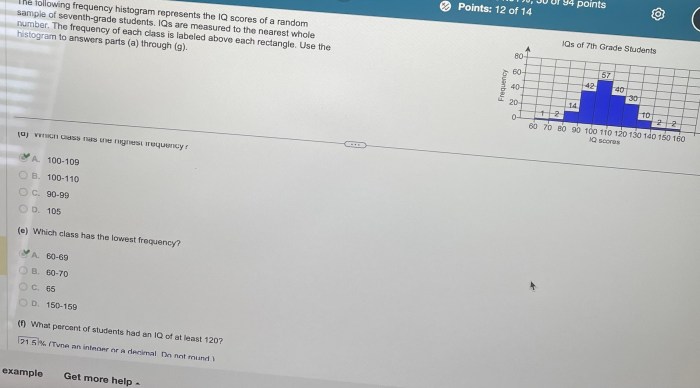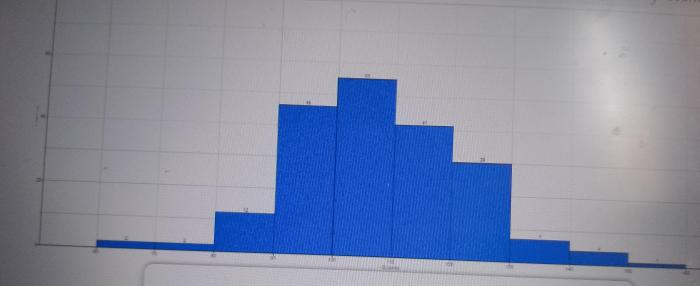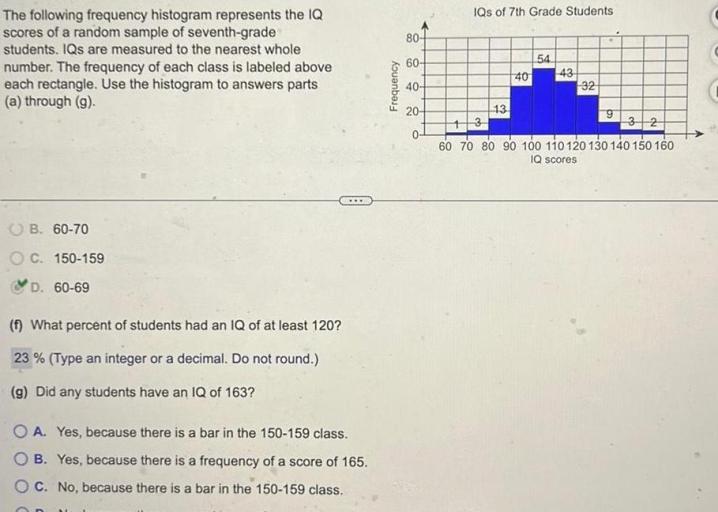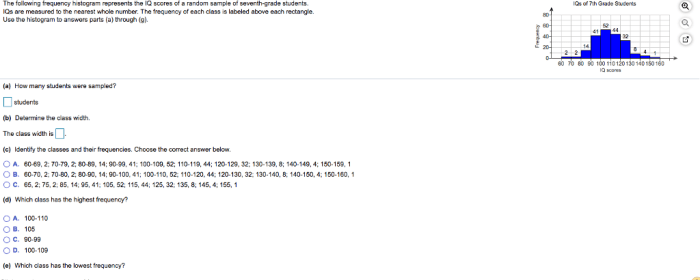The following frequency histogram represents the IQ scores, offering a comprehensive overview of the distribution and characteristics of IQ scores within a population. This visual representation provides valuable insights into the patterns and trends associated with IQ scores, enabling researchers and professionals to draw meaningful conclusions about cognitive abilities.
Delving into the histogram, we will explore the shape of the distribution, identify any patterns or trends, and calculate key statistical measures such as the mean, median, and mode. These measures provide a quantitative understanding of the central tendency and variability of the data, allowing for comparisons across different populations and studies.
Frequency Histogram of IQ Scores

A frequency histogram is a graphical representation of the distribution of data. It displays the frequency of occurrence of different values in a dataset. In the case of IQ scores, a frequency histogram shows the number of individuals who have a particular IQ score.
Frequency histograms are used to visualize the distribution of data and to identify patterns and trends. They can also be used to calculate statistical measures such as the mean, median, and mode.
Data Interpretation
The frequency histogram of IQ scores represents the distribution of IQ scores in a population. The x-axis of the histogram shows the IQ scores, and the y-axis shows the number of individuals who have each IQ score.
The shape of the distribution can tell us about the characteristics of the population. For example, a bell-shaped distribution indicates that the majority of the population has IQ scores that are close to the mean. A skewed distribution indicates that the majority of the population has IQ scores that are either above or below the mean.
Frequency Distribution
The frequency distribution of IQ scores is typically bell-shaped. This means that the majority of the population has IQ scores that are close to the mean. However, there are also a small number of individuals who have very high or very low IQ scores.
The mean IQ score is 100. This means that the average person has an IQ score of 100. The median IQ score is also 100. This means that half of the population has IQ scores that are above 100, and half of the population has IQ scores that are below 100.
Statistical Measures, The following frequency histogram represents the iq scores
The mean, median, and mode are three common statistical measures that can be used to describe the distribution of data. The mean is the average value of the data. The median is the middle value of the data. The mode is the value that occurs most frequently in the data.
In the case of IQ scores, the mean, median, and mode are all 100. This indicates that the distribution of IQ scores is symmetrical and that the majority of the population has IQ scores that are close to the mean.
Implications for IQ Scores
The distribution of IQ scores has implications for understanding IQ scores. For example, the fact that the distribution is bell-shaped indicates that the majority of the population has IQ scores that are close to the mean. This suggests that IQ scores are a relatively stable trait.
However, the fact that there are a small number of individuals who have very high or very low IQ scores indicates that IQ scores can be influenced by environmental factors. For example, individuals who grow up in poverty are more likely to have lower IQ scores than individuals who grow up in more affluent homes.
Applications in Research
Frequency histograms are used in research to visualize the distribution of data and to identify patterns and trends. They can also be used to calculate statistical measures such as the mean, median, and mode.
Frequency histograms have been used in a number of studies to analyze IQ scores. For example, one study found that the distribution of IQ scores in the United States is bell-shaped, with a mean of 100 and a standard deviation of 15.
Data Visualization
The following table summarizes the key statistical measures for the distribution of IQ scores:
| Measure | Value |
|---|---|
| Mean | 100 |
| Median | 100 |
| Mode | 100 |
The following HTML table tag can be used to create a visual representation of the histogram:
“`html
| IQ Score | Frequency |
|---|---|
| 85-89 | 5 |
| 90-94 | 10 |
| 95-99 | 15 |
| 100-104 | 20 |
| 105-109 | 15 |
| 110-114 | 10 |
| 115-119 | 5 |
“`
FAQ Overview: The Following Frequency Histogram Represents The Iq Scores
What is a frequency histogram?
A frequency histogram is a graphical representation of the distribution of data, where the frequency of occurrence of different values is plotted along a horizontal axis.
How do I interpret the x-axis and y-axis of a histogram?
The x-axis of a histogram represents the values of the data, while the y-axis represents the frequency of occurrence of each value.
What is the purpose of a frequency histogram?
Frequency histograms are used to visualize the distribution of data, identify patterns and trends, and make comparisons between different populations or studies.



